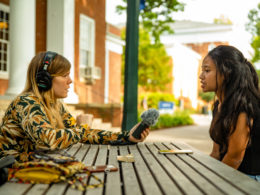As a new calendar year limped its way across the threshold of 2021 this past January, what came with it for local nonprofits was a range of emotions. First, there was a sense of gratitude, an abiding appreciation for the way in which donors responded to unprecedented challenges related to the pandemic. Across the board, nonprofits extolled the generosity of support they received, especially during a year in which their traditional fundraisers were socially distanced right off the calendar. Major funders provided unparalleled flexibility in their grantmaking, giving nonprofits more autonomy on how to spend critical funding. In 2020, amid a national health emergency, there was much to be thankful for.
Astride that gratitude came a dose of relief. There was a palpable expectation that things would turn the corner soon, and that the cadence of pre-COVID operations would return in 2021. It was “just around the corner” was the common wisdom. Perhaps things would not exactly be the same as before, but as the year began there was this sense that a new normal was within reach. Little did we know at the time that delta and omicron variants would have other ideas about the year ahead.
Now, with 2021 in the rear-view mirror, we can objectively assess the year through the lens of local nonprofits. Did it turn out as they expected? Was 2021 more of a repeat of 2020? How were the demands for services affected? Were organizations able to sustain fundraising levels? How did nonprofits respond? And while we’re asking questions, what do nonprofit leaders anticipate for 2022?
Fundraising: the same, but different
A combination of PPP and a base of donors willing to dig deeper characterized fundraising in 2020 for many organizations. And while there was an expectation that development would get back to pre-COVID rhythms, that turned out to be only partially true. During the past year, donors continued to recognize the critical nature of their support – particularly without the lifeboat that was PPP. Many fundraisers returned as in-person events (see our report, for example, on the SPCA’s Fur Ball whose $620,000 gate approached pre-pandemic levels), and some came halfway back, giving “attendees” both remote and in-person options.
The operative word for 2021 on the development front was “engagement,” creating opportunities for donors and potential donors to get connected to the nonprofit’s work. At ChildSavers, for example, the organization hosted small outside gatherings of interested individuals at its Church Hill venue where prospects learned about the nonprofit’s work while taking in sweeping views of Shockoe Bottom and the city below.
“We’ve found these types of gatherings to be quite effective as they have resulted in conversations with more depth and detail,” says L. Robert Bolling, ChildSavers’s chief executive officer. “We remained aggressive in our fundraising efforts, diversifying our community of financial supporters. We have seen an outpouring of generosity from new and long-term donors during the pandemic.”
“In 2020 there was a ‘disaster response’ nature to donor interest. This year, we’ve seen donors dive deeper into the pandemic’s downstream impact on issues like workforce development and education,” observes James L.M. Taylor, president and CEO at the United Way of Greater Richmond & Petersburg. “And all of this has led to an increasingly high level of donor engagement.”
Taylor points to United Way’s “WomenRise” program, which provides childcare scholarships that enable single mothers to complete their education or train for a better job, as an initiative that energized donors during a year in which childcare became even more of a dominant factor in the workplace.
Fundraising also took on a blended approach. The year saw several of United Way’s workplace campaign partners hold successful virtual fundraising efforts, a model that the organization expects to be replicated in 2022. As with ChildSavers, the organization also found small group gatherings with prospective donors to be an effective means for engaging them.
Funders also provided greater levels of flexibility in the COVID climate. The health crisis provided a tipping point for many foundations to move away from restricted grants, and over the past year, this new reality has made a profound difference. UMFS, for example, received $200,000 in unrestricted foundation grants which were critical in helping provide a range of timely services.
“The COVID crisis has challenged long-held notions on how to best raise funds and administer our resources, and truth be told, the results of all that reevaluation have not been all bad. The necessity to think differently has resulted in some positive changes,” says Katie Moore, director of fund development at UMFS. “Moving away from unrestricted grants is not a panacea that will fix all our funding challenges. But doing so will be a healthy step in the right direction.”
Funders recognized how vital this new flexibility would be for nonprofits. Amy Nisenson, executive director at the Mary Morton Parsons Foundation, says that the foundation looked at funding requests on a case-by-case basis with respect to unrestricted funds. It allowed capital money, for example, to be used to address other pressing needs.
“At Parsons, we were willing in this climate to extend deadlines and waived some of the timing with respect to matching grants,” she says. “In other words, we made grants without a match so the organization could start their work, especially if it was critical to operations. We made it a special point to listen and work with them.”
Demand for services remained high
As fundraising continued apace, so did demand for services, and in many cases the pandemic exacerbated issues beyond the capacity to meet them. Children’s mental health is a case in point. Last October, the American Academy of Pediatrics, the American Academy of Child and Adolescent Psychiatry and the Children’s Hospital Association sounded the alarm on the issue. The organizations collectively declared a national emergency in children’s mental health. They noted the serious toll that COVID-19 was having on the mental health of the nation’s children.
According to ChildSavers’s Bolling, that spike in demand has been felt in Richmond, noting the need for mental health services for children has reached an all-time high.
“Children’s mental health was severely impacted during the pandemic and ongoing race and social justice issues,” he says. “Interruptions to routines left children isolated and anxious while simultaneously experiencing trauma, grief and loss.”
During 2021, ChildSavers saw a dramatic and frightening spike in the severity of cases, including a 66% increase in the number of hospitalizations for suicide attempts and high-risk behaviors. One safety assessment tool found an 80% rise in the need for hospitalizations to prevent clients from harming themselves or others.
The uncertainty about the future has not only affected children but vulnerable populations more broadly. And the impact goes beyond mental health to affecting longstanding community issues.
“Living with and recovering from the pandemic presents a range of unique challenges,” says the United Way’s Taylor. “These are layered on top of longstanding issues like homelessness, access to education and more. In 2021, we found that the most effective programs address both pandemic recovery and pre-existing community needs, since all of these challenges are interconnected.”
For example, United Way’s Ride United program, which provides on-demand Lyft rides for people without other transportation options, started as a way for people to get to vaccine and testing sites. But before long, the program expanded by offering rides to a greater range of services, like education, employment, health care and more.
One of the most critical needs during the health crisis – even beyond traditional demand – has been in childcare. What has happened to the availability of affordable childcare during the pandemic has been staggering. Prior to the onset of COVID, Virginia had just over 6,000 licensed childcare providers with space available for 392,000 children. By last August, nearly 2,200 providers – more than a third – had closed, thereby eliminating 168,000 slots. In other words, 43% of the seats available pre-pandemic have been lost. Despite progress in many areas, the availability of childcare has yet to reach pre-pandemic levels of enrollments and availabilities.
ChildSavers works with more than 600 childcare providers, largely family day home providers who stayed open to families during the pandemic.
“We’re striving to meet childcare needs in the community by creating spaces that are safe, nurturing, equitable and developmentally appropriate for children,” Bolling says. “That’s also how we can help prevent childhood trauma from occurring.”
Steps toward normalcy
What’s clear after a second year living through a pandemic is that nonprofits are figuring it out, and they recognize that while things may not return to pre-COVID operations any time soon (if ever), they are growing increasingly comfortable finding new ways of providing their services. And they’ve discovered that some of the changes that they made during the crisis are worth keeping.
“I think we can all agree that our ‘normal’ is evolving, and everyone will continue to adapt to their own sense of normalcy over time,” observes Bolling. On the one hand, the organization is working hard to train more childcare professionals and take on additional therapists to address demand, and at the same time, it’s working to become more responsive to race and social equity issues. “We are shifting to a more proactive, less reactive model regarding our diversity, equity and inclusion efforts.”
That kind of strategic thinking rings true to Nisenson, who also provides strategic planning and board development consulting to nonprofits.
“I’m seeing the leadership at nonprofit organizations beginning to look at strategic planning and fundraising in different ways,” she says. “COVID has made people take a different look at how to best move forward strategically, how to engage in different ways. They’re asking if it’s time to stop doing ‘business as usual.’”
That new way of thinking also affects how the staff at nonprofits do their jobs. The United Way has mostly been working remotely since spring 2020 and has implemented a new remote work policy that allows employees more flexibility and increases social distancing. The organization has invested in upgraded technology for virtual meetings and remote work.
“All of this has been a positive step forward for our organization,” Taylor says. “Being forced to go fully virtual for the safety of our community allows us to discover the benefits of online options for both programming and fundraising. While we still love and prefer in-person, hybrid is here to stay. We believe that offering virtual AND in-person programming and fundraising allows us to reach more audiences in a more effective way.”
At the same time, during 2021, United Way saw the return to some services that had not been available on an in-person basis. Its Kindergarten Countdown Camp returned to an in-person format, while others continued with a hybrid model, such as Volunteer Income Tax Assistance.
Hybrid offerings also have been a solution at ChildSavers, which pivoted to offering teletherapy for children and online training for childcare professionals, even as in-person therapy sessions returned in 2021.
“Teletherapy has enabled us to increase our service capacity and meet pandemic-related needs,” Bolling says. He notes that during the height of pandemic, some 95% of therapy sessions were conducted online, while today, that number is closer to 70%.
Looking ahead
While there is an abiding sense of uncertainty as 2021 turns to 2022, there also is a palpable sense of optimism among nonprofits that they will be able to respond to whatever hurdles are in their paths. If past is prologue, donor support should continue to be strong. New models of operating are taking hold. And funders continue to show a willingness to be flexible and accommodating. There also is a sense of collaboration that is fueling some momentum going into the new year.
“Parsons has really benefited from working with other funders over the past year or so,” Nisenson says, “And that has led to making better-informed decisions. We are by and large gatekeepers, not necessarily specialists in particular areas, so we are smarter when we share information and expertise with one another. I hope this spirit of collaboration continues well into the future.”










